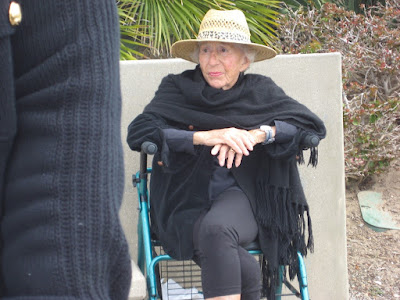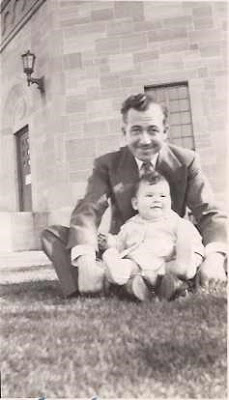Sharon
and I were perched above a three-tiered cluster to multi-million-dollar homes
in Dana Point. The last time we had visited that lookout, there was only one
row of homes facing the Pacific Ocean. Now two more tiers of timber had been
added to the terrace of serious wealth perched there. Rumor had it that Arnold
Schwarzenegger had a home whose front was all glass and showcased his gym
equipment. True or not, it made for some interesting conversations.
I’m
told there was a fire sale back in 2008 during the recession. One could steal
an ocean-view lot for only eight to ten million dollars; much less than their
pre-recession prices of double that amount. Now those homes were packed tighter
than sardines with zero lot lines and a perfectly magnificent view of their
neighbor’s roofline. Welcome to the sometimes foggy always colorful coast of
California where sites and senses never disappoint. Back at the overlook, one
of those came inching by.
It
was an old lady dressed in black and moving slowly along with her walker. She
had sad eyes the color of fog yet branded a weak smile which seemed to welcome
inquiries. As she sat down across from us, her eyes washed over mine several
times but never stuck. She seemed lost in her own thoughts…and perhaps dreams
of times past. It didn’t seem right to disturb her. Eventually the woman’s
daughter came by to retrieve her and they left together. A hundred thousand
stories and ‘what if’s’ slowly shuffled away.
On
yet another jog out of our comfort zone, we returned to old Spanish California.
Back to a time and place before the first Americans populated the land. It was
one of the many mission churches that dotted the coast of California long
before freeways and housing erased any vestiges of their past.
Mission
San Juan Capistrano has been home to many indigenous and native peoples and now
swallows for over 230 years of its storied history. The mission was initially
founded in 1775 by Father Lasuen. He and his fellow padres left the mission for
San Diego and it was re-founded by Father Serra on All Saint’s Day, November 1st,
1776.
The
mission became the seventh of twenty-one missions to be founded in Alta
California. Like the previous six missions, San Juan Capistrano was established
to expand the territorial boundaries of Spain and to spread Christianity to the
Native Peoples of California.
For
over the next 30 years, Mission San Juan Capistrano grew in population,
buildings, livestock, and prominence. By
1806, the mission had a population of over a 1000 people, over 10,000 head of
cattle, and a completed architectural gen, the Great Stone Church.
Like
all great monuments to the moment, the mission began to decline over the years.
By 1821, Mexico had won its independence from Spain and made Alta California a
territory of Mexico. There was yet another government take over when the United
States won the Mexican American War in 1848.
Fast-forward
a hundred years and the Catholic Church got its mission back, wealthy donors
began campaigns for restoration and a clever priest decided to capitalize on a
yearly phenomenon of returning swallows to highlight the mission’s fund-raising
efforts.
Long
before long-limbed nymphs and their male counterparts played volleyball on a
Sunday afternoon, Laguna Beach has attracted sun-worshipers and visitors as
well as those seeking to expand their consciousness.
In
the early 1900s Laguna Beach was a magnet for plein air painters, poets and
artists interested in expanding their realm of consciousness. In the early
sixties LSD was openly manufactured there. Café Frankenstein was a hangout for
beat poets and artists. At night after the tourists left, Hare Krishna dancers
and chanters came out in force. The air was thick with grass. There was a
street scene alive with kaleidoscopic light shows and abstract works which
referenced social and political issues of the time and environmental issues.
Now
it’s a prime spot for watching the Southern California beach scene unfold.
Beach Boy wannabes and weekend surfers ride the waves of imagination and salt
air. Young women and old one’s alike wear little for the imagination and old
men with too much imagination hang over the pier railing and wonder ‘what if…a
long time ago…’
Further
up the PCH, Crystal Cove State Park is a wildness wonderland that includes over
2,400 acres of undeveloped woodland and three and a half miles of beaches.
There are forty-six old style cottages in the cove being restored to their
1930s to 1950s-era designs.
We
got there just in time to watch the sun dropping its pedals along the
shoreline. Sunsets at Crystal Cove rival that of Malory Pier in Key West and
are just as breath-taking. It was quintessential California with all of its
clichés and sublime charms combined. A soul-satisfying place to share with
someone else if only for those brief moments in time.
And
just like the lady with eyes of fog it was a memory basin filled with the
sounds of young children tempting the surf, old women wondering where their
time had gone and one inquisitive writer looking for another tale to tell.
















































